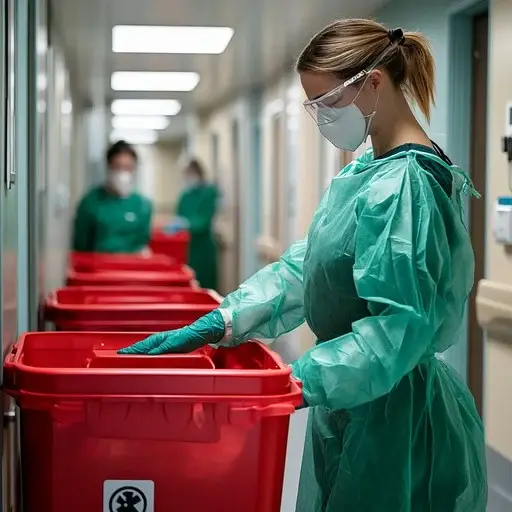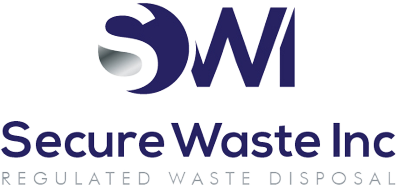Packaging Medical Waste | Medical Waste Disposal
Ensuring Effective Medical Waste Packaging
Proper disposal of regulated medical waste (RMW) is essential for any healthcare facility, including doctor’s offices and urgent care centers. This waste can contain harmful infectious materials, so careful packaging and transport are vital for the safety of staff, patients, and the environment. Complying with federal, state, and local regulations demonstrates a commitment to community well-being.
In this article, we’ll share practical methods for segregating and packaging medical waste, promoting a healthier environment for everyone!
To ensure your organization remains compliant and safe, follow these five essential steps for packaging medical waste effectively. Your commitment to proper procedures protects your staff and patients and contributes to a safer environment.
Step 1: Choose a Suitable Container
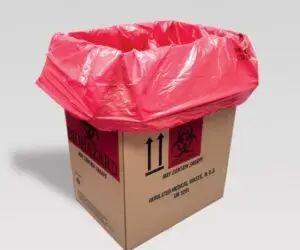
Organizations have exciting options for managing regulated medical waste using corrugated medical waste boxes or specially designed reusable containers! If you choose corrugated boxes, remember to securely seal the bottom flaps with two-inch-wide, clear packing tape.
It’s essential to clearly label the top and bottom with printed text and arrows for easy identification. Reusable containers are fantastic, too, as they don’t require any unique setup!
Adequate segregation is the crucial first step in adequately packaging medical waste. Understanding the various types of garbage and selecting the proper containers for each makes the process smooth and safe. Let’s make waste management efficient together!
Step 2
When managing biohazardous waste, such as blood-soaked materials, contaminated sharps, or other bodily fluid-saturated items, using the appropriate vendor-supplied biohazard corrugated box or reusable container is essential. These containers are DOT-approved, ensuring safe medical waste transport—a vital step in protecting our community! 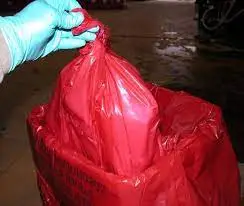
If you want a single-use box or a reusable container, please always remember to line it with a red biohazard bag, usually provided by your medical waste disposal vendor. You can line the Medical Waste Container with the Appropriate Bag. Gently line the inside of your receptacle with a red biohazard bag, ensuring it extends over all four sides for a secure fit. Don’t forget to adhere to state-specific regulations regarding bag thickness and weight limits. Together, we can ensure a safer environment for everyone!
Step 3 Place the Appropriate Medical Waste in the Lined Container
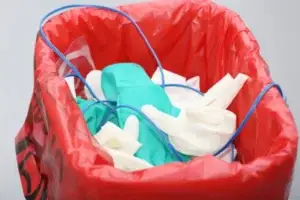 Every state has guidelines for regulated medical waste, making it crucial to understand what can be safely disposed of in designated waste containers. Medications, loose needles, scalpels, general trash, and recyclable materials should never go into a red bag. It’s also essential to adequately handle specialized waste, such as trace chemotherapy and pathological waste, which requires separate disposal in designated incineration containers.
Every state has guidelines for regulated medical waste, making it crucial to understand what can be safely disposed of in designated waste containers. Medications, loose needles, scalpels, general trash, and recyclable materials should never go into a red bag. It’s also essential to adequately handle specialized waste, such as trace chemotherapy and pathological waste, which requires separate disposal in designated incineration containers.
If you’re dealing with sharps waste—like needles, syringes, and scalpels—please use a puncture-resistant, disposable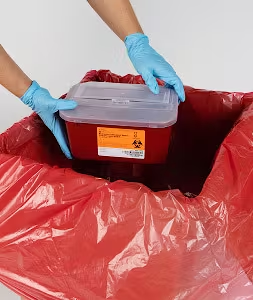 sharps container. Keeping these sharp items safe is essential, so never place them directly into the biohazard box. Instead, first, make sure they are securely contained within the sharps container.
sharps container. Keeping these sharp items safe is essential, so never place them directly into the biohazard box. Instead, first, make sure they are securely contained within the sharps container.
When the sharps containers are sealed, they can be placed into the biohazard box or an approved reusable container for safe disposal. We’re committed to ensuring safe practices and appreciate your diligence in following these steps.
For more insightful tips on sharps safety, click here to explore Simple Steps to Sharps Safety. Your cooperation makes a significant difference!
Step 4
As you fill your biohazard box, remember the DOT-approved weight limit of 40 lbs to ensure a smooth and efficient process. Adhering to this limit helps avoid any potential fees or fines, allowing us to focus on what truly matters—keeping everyone safe!
Remember to don your protective equipment (PPE) when managing the red bag and proceed with care. To securely close the red bag, twist the top and tie it with a simple knot to contain the medical waste effectively and prevent leaks.
Once the bag is full, leave a little space at the top and gather the edges. While wearing gloves, twist the bag’s top to seal the contents tight and make a solid knot—a single or gooseneck knot works well. If it feels more secure, feel free to use a zip tie or tape for added assurance.
Next, it’s essential to ensure your transport container is sealed correctly. If using a reusable container, engage the auto-locking flaps or secure the lid as needed. For corrugated boxes, use two-inch-wide clear packing tape to seal the top effectively.
Finally, remember that the red bags should be completely hidden from view once your outer container is closed and sealed. Proper packaging is vital; any overlooked details might lead to pick-up issues. Thank you for your diligence and commitment to safety! We can make a positive impact together.
Step 5
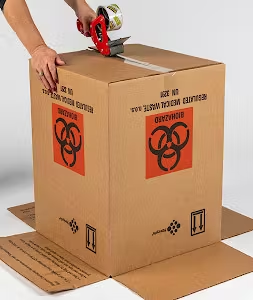 Once you’ve safely placed the red bag inside the biohazard box or reusable container, it’s time to secure everything for safe transport! If using a single-use box, close the flaps and seal the top with a 2-inch wide tape strip. Remember to tape the bottom securely before use for added safety. For reusable biohazard containers, attach the lid firmly, keeping a keen eye out for any obstructions. It’s also important to properly label the box to align with federal, state, and local regulations, including any necessary barcodes for the waste hauler. To ensure your organization adheres to best practices in packaging regulated medical waste (RMW), consider contacting an RMW management expert. This proactive approach can enhance safety and compliance in your waste management processes. Together, we can ensure a safer, cleaner environment for everyone!
Once you’ve safely placed the red bag inside the biohazard box or reusable container, it’s time to secure everything for safe transport! If using a single-use box, close the flaps and seal the top with a 2-inch wide tape strip. Remember to tape the bottom securely before use for added safety. For reusable biohazard containers, attach the lid firmly, keeping a keen eye out for any obstructions. It’s also important to properly label the box to align with federal, state, and local regulations, including any necessary barcodes for the waste hauler. To ensure your organization adheres to best practices in packaging regulated medical waste (RMW), consider contacting an RMW management expert. This proactive approach can enhance safety and compliance in your waste management processes. Together, we can ensure a safer, cleaner environment for everyone!
In Closing
As a valued medical waste generator, your role is essential in ensuring the safe transport and disposal of regulated medical waste. By securely packaging it, you protect your team and others involved. We can foster a safer environment and reinforce our commitment to health and safety!
